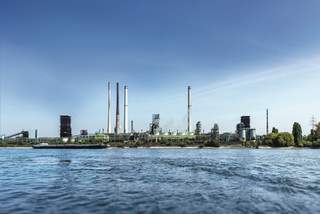
thyssenkrupp - Construction of the first direct reduction plant at the Duisburg site © thyssenkrupp
Hydrogen instead of coal: Steel production goes green
Whether for buildings, cars, computers or sinks - steel is one of the most important basic materials in many industries and areas of life. The strong and inexpensive metal is also indispensable for the energy turnaround, as it is used in both electricity pylons and wind turbines. At the same time, steel production in its current form is responsible for around seven percent of global CO2 emissions, further fueling climate change. Germany's biggest steel producer thyssenkrupp therefore sees the transformation of steel production as a major lever for mastering the transition to a climate-neutral society. The company aims to make its own steel production climate-neutral by 2045. To this end thyssenkrupp is already investing heavily in its sites and introducing innovative sustainable technologies.
On the way to a furnace 2.0
The basic material for steel production is iron ore. In furnaces, coal and carbon are used to produce molten pig iron, which thyssenkrupp processes into high-quality flat steel. Inevitably, carbon dioxide is produced in the process. In the future this process will be different: thyssenkrupp plans to use green hydrogen instead of coal for iron reduction; instead of CO2, water vapor will then be produced.
At the heart of the tkH2Steel transformation project are state-of-the-art direct reduction (DR) plants which will gradually replace the blast furnaces. They produce solid sponge iron (Direct Reduced Iron, DRI) rather than liquid pig iron.
To turn DRI into high-quality carbon steel, the Group has to liquefy it again. For this step thyssenkrupp has developed a completely new unit: the melter powered by green electricity.
The liquid electric pig iron produced in this way is identical to the iron previously produced in the blast furnaces. All further production steps can therefore take place in the existing infrastructure, and the new facilities will integrate seamlessly into the smelter network. "We are abolishing coal, not the steel mill," says Arnd Köfler, Chief Technology Officer at thyssenkrupp Steel.
The Ruhr region plays a leading role in the energy transition
The center of climate-neutral steel production will be the Ruhr region. Last year the thyssenkrupp Executive Board approved an investment of more than two billion euros for the Duisburg site, paving the way for one of the biggest industrial decarbonization projects in the world. At the beginning of March 2023 the next step towards implementation was taken: thyssenkrupp Steel commissioned the Düsseldorf-based SMS group to supply and build the hydrogen-based DR plant including two melters. The new plant is scheduled to go on stream in 2026 and replace two blast furnaces by 2030. "In 2030, we are already planning to produce around five million tons of low-CO2 steel and then realize CO2 savings of well over 30 percent," says Arnd Köfler. The transformation to completely climate-neutral production is to be completed by 2045 at the latest.



